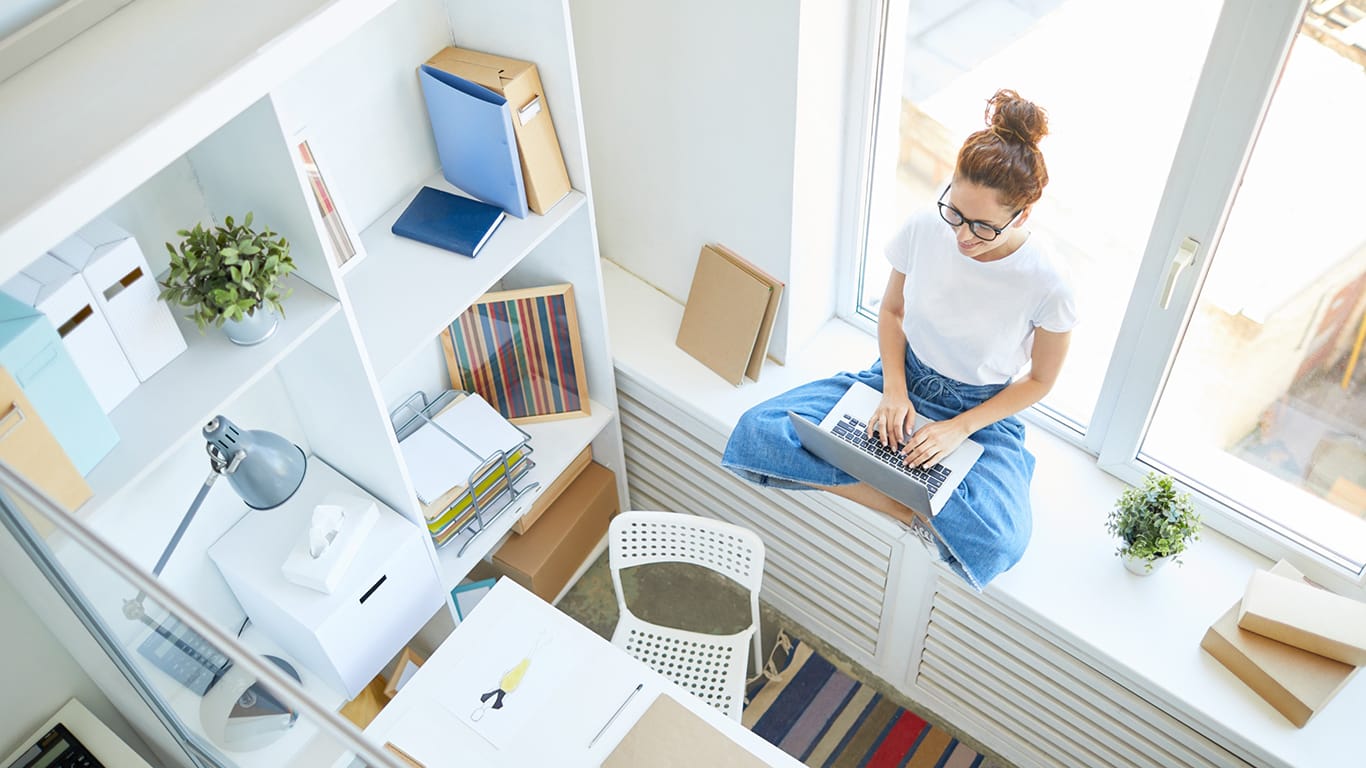Designing for small spaces: 15 tips and strategies from homeowners
Unlock the full potential of your compact living quarters with actionable strategies direct from seasoned homeowners. This article distills key advice from design aficionados who have mastered the art of maximizing minimal space. Step into a world where every inch counts, and learn how to transform tiny confines into stylish, functional havens.
FOOD NEWS: 10 celebrity chef restaurants to try in Arizona
THINGS TO DO: Want more news like this? Get our free newsletter here
- Treat Small Space Like Diva Client
- Think Vertically for Small Spaces
- Anchor Room with Substantial Pieces
- Invest in Multi-Functional Furniture
- Use Walls to Maximize Space
- Choose Smart, Functional Furniture
- Set an Intention for the Space
- Stack Appliances and Add Fold-Out Benchtop
- Use Properly Sized Appliances and Cabinets
- Use Mirrors to Open Up Space
- Add Texture for Visual Interest
- Use High-LRV Neutrals to Expand Room
- Mount Mirrors and Use Vertical Storage
- Use Proportionally Designed Furniture
- Use Strategic Lighting to Expand Space
Treat Small Space Like Diva Client
My best advice for working with a small space is to treat it like a diva client with expensive taste and very limited patience. You must give it attention, purpose, and a little bit of drama–without letting it spiral into chaos. I do not tolerate rooms that feel like storage closets in denial.
One strategy that worked beautifully in my own home was swapping bulky furniture for slim, multifunctional pieces. I replaced a chunky armchair with a vintage cafe chair that doubles as extra seating and an occasional plant stand, depending on my mood and the season. I also mounted a shelf above eye level to display florals and books, which made the ceiling feel taller and gave the illusion that I live in a well-curated Paris apartment instead of a very enthusiastic shoebox.
By using vertical space, editing like a designer with no emotional attachment to clutter, and adding one bold, beautiful element–like wallpaper or oversized art–I turned a small room into a space that feels intentional, not apologetic. Guests now walk in, pause, and say, “This is so you.” I consider that a win and reward myself with fresh peonies.
Magda Callery, Interior Designer, Style By Magda
Think Vertically for Small Spaces
I’ve been in the remodeling industry for over 20 years, working on everything from kitchens to bathrooms–and let me tell you, I know a thing or two about making small spaces work. With four kids, two grandchildren, and a busy life, I’ve learned to get creative with every inch of space I have, both at home and with my clients.
When it comes to working with a small space, the first thing I always tell people is: think vertically! Vertical storage is your best friend. Whether you have a tiny bathroom or a cramped kitchen, use the height of your walls to your advantage. I’ve installed floating shelves, tall cabinets, and even built-ins that go all the way up to the ceiling. It makes a world of difference!
In my own home, I have a small powder room where I installed a floating vanity and open shelving for towels. Not only does it keep everything organized, but it also keeps the room feeling open and airy–nothing feels more claustrophobic than bulky furniture in a tiny room.
Another trick? Light colors–they’re a game-changer. I’m not saying you have to go completely white (though it works wonders!), but lighter tones like soft greys, creams, and even pastels can make the space feel much bigger than it actually is. I did this with my own bathroom recently, and adding a large mirror opposite the window makes the room feel twice as large. Plus, it bounces light around.
Lastly, I always tell my clients that function is just as important as style–especially when you’re working with limited space. I’m all about using high-quality materials that are built to last (which is why I’m a big fan of Moen plumbing products–those warranties are hard to beat). If you’re thoughtful about your design and use smart, budget-friendly solutions like reusing materials when possible, you can make even the tiniest space feel like a million dollars. Small spaces don’t have to be a challenge–they just require a little creativity and a good eye for what will make the most impact. And, remember, it’s all about balance. You can have style, function, and space all at the same time.
Melody Stevens, Owner, Design On A Dime Interiors
Anchor Room with Substantial Pieces
It sounds counterintuitive, but one of the best things you can do in a small space is to use the largest furniture pieces possible while maintaining comfortable circulation. A common mistake I see as an interior designer is homeowners filling small rooms with lots of little furniture pieces, which actually makes the space feel smaller. Instead, anchor the room with substantial pieces — a full-size rug, a proper sofa, a generously scaled bed — and let the negative space around them breathe. Fewer, bolder pieces can make a small space feel intentional and elevated instead of cluttered.
Courtney Batten, Principal Interior Designer, Paige Studio
Invest in Multi-Functional Furniture
The most efficient method for handling limited areas is to invest in furniture that performs various functions. For instance, storage ottomans along with fold-down workstations and display shelves help you achieve maximum space efficiency while maintaining an organized appearance. Select furniture items that serve dual purposes to optimize the use of space, including beds with hidden storage and dining tables that function as work areas.
The arrangement of space along walls has created effective solutions within my residential environment. I established portable shelves and wall-mounted hooks to incorporate daily items among furniture pieces while keeping the floor free from clutter. I selected light neutral hues for both walls and furniture to achieve an open environment with an airy atmosphere. Placing mirrors strategically beside windows created a sequence of visible natural lighting that enhanced both the scale and welcoming appeal of the room.
Tatiana Colligan, Owner, Buy Best Chest
Use Walls to Maximize Space
When square footage is scarce, look up–walls are your greatest ally. Install floor-to-ceiling shelving or wall-mounted cabinets to stash essentials while keeping floors clear. Light, neutral tones and slim profiles maintain airiness, turning clutter into curated displays that emphasize height over crowding.
Mirrors aren’t just decor–they’re space expanders. Position a large mirror opposite a window to flood the room with reflected light and double its perceived size. Pair it with cohesive colors (soft whites, muted grays) to unify the space and avoid visual chaos.
Dual-purpose furniture is non-negotiable. Opt for a storage ottoman, fold-down desk, or sleeper sofa that serves two needs in one footprint. This eliminates clutter and ensures every piece earns its keep, blending practicality with polished design in tight quarters.
Nancy Dow, Interior Designer, Sierra Living Concepts
Choose Smart, Functional Furniture
Maximizing a small space is all about smart, functional choices. In my own home, I’ve found that multi-functional furniture, like a sofa that doubles as a guest bed or a coffee table with hidden storage, really helps create more space without feeling cramped. Vertical storage is another key: shelves and wall-mounted racks free up the floor and keep things organized. This approach has worked wonders for my clients too. Just ask Sarah, who transformed her small apartment into an organized, peaceful haven with these simple strategies. At Revive My Spaces, we believe that with the right planning, even the smallest spaces can feel open and clutter-free.
Lauren Hammer, Founder & Lead Organizer, Revive My Spaces
Set an Intention for the Space
My best advice for working with a small space is to set an intention for the space. Decide if it is meant for relaxation, storage, or something else. This helps you prioritize what’s more important and provides a clear direction for your design, ensuring the space serves your needs effectively while maintaining a cohesive, functional layout.
One design strategy that has been particularly effective in maximizing a small room in my home is using color to enhance the sense of space. Color can be a powerful tool to define distinct areas within a small room, create emphasis or focal points, and even subtly conceal items or features that might otherwise clutter the space. By strategically choosing the right shades, a room can feel larger, more organized, and visually balanced.
April Dishno, Interior Designer, CRD Design Build
Stack Appliances and Add Fold-Out Benchtop
One of my favorite small-space design wins comes from my own laundry at home. I stacked the washer and dryer to free up floor space, but still needed somewhere to actually fold clothes (because balancing a laundry basket on top of a dryer isn’t ideal). So I added a fold-out benchtop mounted to the wall beside the appliances. It flips down when I need it, folds away when I don’t, and gives me a proper work surface without crowding the room.
The trick with small spaces is getting them to flex. If it can tuck away, do double duty, or make use of a wall that would’ve gone ignored, it’s a win in my book.
Angelique Kreller, Interior Designer, Yabby
Use Properly Sized Appliances and Cabinets
I look at every space as if it is a puzzle where I suggest things such as appropriately sized appliances and/or furniture, make sure all the cabinets with specialized interior storage are in proper placement to work areas, and provide clear floor space where applicable. I would say that providing proper lighting is the biggest part of design in any size space, whether you want to illuminate an area or work with shadows to add depth.
Referring to my own home’s half bath that is around 20 square feet: I started with the basics, the toilet and sink. The problem that I faced when selecting the fixtures was that the door swings into the bathroom, limiting the depth of the sink. I didn’t want to put a pedestal sink in the space because I wanted a bit of storage for cleaning supplies. So, I found a wall-mount sink that gives enough area on top for hand soap as well as shallow depth storage below. I even painted the walls a dark red. One may think that dark walls in a small space make it feel smaller, but with proper lighting, the space doesn’t feel any more cramped than if I had white walls; the size of the space is what it is. Don’t forget to add areas of texture where you can. In my case, I added an accent to the ceiling to provide a little interest.
Abigale Anderson, Project Manager, Upscale Remodeling
Use Mirrors to Open Up Space
A small room doesn’t have to feel small. The easiest, most effective way to open up a space without tearing down walls? Mirrors.
Mirrors work like optical illusions—they reflect light, color, and space, instantly making a room feel larger and more open. Hanging one opposite a window amplifies light and brightness, while a floor-to-ceiling mirror can give the impression of higher ceilings and wider walls.
I’ve personally used this trick in my home. I placed an oversized mirror in a compact entryway, and suddenly, it felt twice the size. Instead of feeling cramped, it became a less confined, welcoming space—all thanks to one simple design move.
If you’re battling limited square footage, don’t underestimate the power of reflection. One mirror equals double the space.
Ron Ramos, Manager, Plano Home Renovation
Add Texture for Visual Interest
My best advice for working with a small space is to make smart use of texture and visual interest rather than overwhelming the area with furniture or decor. One strategy that transformed my own small home office was installing a thin brick veneer accent wall.
Initially, the room felt tight and visually flat. Adding a brick accent wall introduced warmth and depth, making the room feel intentionally styled rather than cramped. The bricks’ subtle texture and pattern created the illusion of more space, drawing the eye upward and adding visual interest without taking up precious floor area.
For those working with limited square footage, I highly recommend accent walls to bring character and dimension. Choose materials that add texture without overpowering the space. Brick veneers, specifically, strike that perfect balance, delivering both visual appeal and space optimization.
In my experience, thoughtfully introducing texture into small spaces can completely change how the room feels and functions. Instead of feeling confined, my workspace now feels inviting and purposeful, proving that even small areas can have a significant impact when designed thoughtfully.
Saltuk Doganci, Founder/Owner, Brick My Walls
Use High-LRV Neutrals to Expand Room
A small room doesn’t have to feel small. The fastest, most effective way to create the illusion of space is to choose high Light Reflectance Value (LRV) paint colors.
LRV measures how much light a color reflects–on a scale from 0 (pure black) to 100 (pure white). The higher the LRV, the more light bounces around the room, making it feel open and airy.
Best Colors for Small Spaces:
- Sherwin-Williams Alabaster (LRV 82) – A warm off-white that brightens without feeling sterile.
- Benjamin Moore Classic Gray (LRV 74) – A soft and light grey that expands space while adding warmth.
- Behr Swiss Coffee (LRV 84) – Perfect for creating an open, expansive feel in tight areas.
A simple paint change can visually double the size of a room–without knocking down a single wall.
Hilary Schultz, Real Estate Investment Professional and Realtor, Bright Bid Homes
Mount Mirrors and Use Vertical Storage
I recently transformed my tiny home office by mounting a large decorative mirror opposite the window, which literally doubled the perceived space and bounced natural light throughout the room. Having worked in countertop design for years, I’ve learned that vertical storage solutions and reflective surfaces are game-changers. I now use floating shelves and glass cabinet fronts to keep the space feeling open while maximizing storage.
Pablo Cavalcante, Owner, Legacy Countertops
Use Proportionally Designed Furniture
Use proportionally designed furniture. For example, do not use a sofa in the space. Instead, use a loveseat or two that will fit better in a small space. Also, use light colors that will not overwhelm the space. You can paint one wall with a slightly darker color as an accent wall, but not all the walls. Lastly, make sure the room does not look cluttered. Too many items on tables or desks will make the room look cluttered. Avoid this.
Maria Luisa Castellanos, President/Architect, United Architects, Inc.
Use Strategic Lighting to Expand Space
When dealing with limited square footage, my top suggestion involves strategic lighting. Think of light as a design element capable of expanding perceived space. A particularly successful tactic I’ve used in my own home involves layering light sources.
I started with general ambient lighting – nothing fancy, just enough to illuminate the entire room evenly. Then, I added task lighting where it was needed, like a small lamp near my reading chair. The key ingredient was introducing accent lighting to highlight artwork and architectural features.
By directing light upward, you draw the eye up, making the ceilings appear higher. Similarly, washing a wall with light makes the room seem wider. What makes it so effective is that it creates depth and prevents the eye from focusing on the room’s boundaries. Well-placed lighting eliminates shadows that can make a room appear cramped and unwelcoming. I suggest you consider incorporating these lighting tips in your next small space project.
Matt Little, Owner & Managing Director, Festoon House
Related Articles
- Real estate: Top tips to consider when designing your home
- AZ Big 100: 50 Arizona businesses to watch in 2025
- Tips for selling your home quickly and profitably – AZ Big Media




